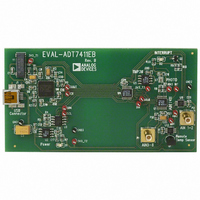EVAL-ADT7411EBZ Analog Devices Inc, EVAL-ADT7411EBZ Datasheet - Page 9

EVAL-ADT7411EBZ
Manufacturer Part Number
EVAL-ADT7411EBZ
Description
BOARD EVALUATION FOR ADT7411
Manufacturer
Analog Devices Inc
Datasheet
1.ADT7411ARQZ.pdf
(36 pages)
Specifications of EVAL-ADT7411EBZ
Sensor Type
Temperature
Sensing Range
-40°C ~ 120°C
Interface
DSP, I²C, MICROWIRE, QSPI, SMBus, SPI
Sensitivity
±0.5°C
Voltage - Supply
2.7 V ~ 5.5 V
Embedded
No
Utilized Ic / Part
ADT7411
Lead Free Status / RoHS Status
Lead free / RoHS Compliant
TERMINOLOGY
Relative Accuracy
Relative accuracy or integral nonlinearity (INL) is a measure of
the maximum deviation, in LSBs, from a straight line passing
through the endpoints of the ADC transfer function. A typical
INL vs. code plot can be seen in Figure 10.
Total Unadjusted Error (TUE)
Total unadjusted error is a comprehensive specification that
includes the sum of the relative accuracy error, gain error, and
offset error under a specified set of conditions.
Offset Error
This is a measure of the offset error of the ADC. It can be
negative or positive. It is expressed in mV.
Gain Error
This is a measure of the span error of the ADC. It is the
deviation in slope of the actual ADC transfer characteristic
from the ideal expressed as a percentage of the full-scale range.
Offset Error Drift
This is a measure of the change in offset error with changes in
temperature. It is expressed in ppm of full-scale range/°C.
Gain Error Drift
This is a measure of the change in gain error with changes in
temperature. It is expressed in ppm of full-scale range/°C.
Rev. B | Page 9 of 36
Long-Term Temperature Drift
This is a measure of the change in temperature error with the
passage of time. It is expressed in degrees Celsius. The concept
of long-term stability has been used for many years to describe
by what amount an IC’s parameter would shift during its
lifetime. This is a concept that has been typically applied to both
voltage references and monolithic temperature sensors.
Unfortunately, ICs cannot be evaluated at room temperature
(25°C) for 10 years or so to determine this shift. As a result,
manufacturers typically perform accelerated lifetime testing of
ICs by operating ICs at elevated temperatures (between 125°C
and 150°C) over a shorter period (typically between 500 hours
and 1,000 hours). Because of this operation, the lifetime of an
IC is significantly accelerated due to the increase in rates of
reaction within the semiconductor material.
DC Power Supply Rejection Ratio (PSRR)
The power supply rejection ratio (PSRR) is defined as the ratio
of the power in the ADC output at full-scale frequency f to the
power of a 100 mV sine wave applied to the V
frequency fs.
where:
Pf is the power at frequency f in ADC output.
Pfs is the power at frequency fs coupled into the V
Round Robin
This term describes the ADT7411 cycling through the available
measurement channels in sequence, taking a measurement on
each channel.
PSRR (dB) = 10 log(Pf/Pfs)
DD
supply of
DD
ADT7411
supply.




















